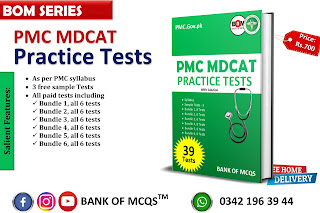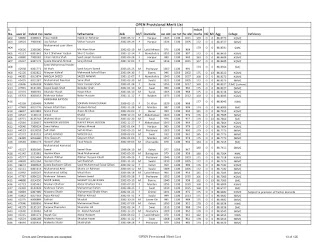chemical bonding MCQs
CHAPTER 5
CHEMICAL BONDING
Q. 1. Which of the following compounds
has maximum ionic character?
a. NaCI
b. CsF
c. KBr
d. MgCI2
(b)
Q. 2. Which of the following molecules
or ions is nonplanar, i.e., has at least one atom that is not
in the same plane as the others?
a. BH3
b. NF3
c. SO3
d. CO3
(b)
Q.3. Which of the following best
describes the shape and polarity of the carbon disulfide, CS2, molecule?
a. bent and polar
b. linear and non-polar
c. pyramidal and polar
d. bent and non-polar
(b)
Q. 4. Which of the following molecules
has the smallest angle between adjacent bonds?
a. CO2
b. CH4
c. H2O
d. NH3
(c)
Q.5. The shape of hydronium ion H3O+
is:
a. planar
b. see-saw
c. trigonal planar
d. trigonal pyramidal
(d)
Q. 6. Which of the following pairs of
atoms are least likely to form an ionic compound?
a. Ni, O
b. Na, F
c. Cu, CI
d. Li, Mg
(d)
Q. 7. Which of the following pairs of
atoms are most likely to form a covalent compound?
a. Na, F
b. Cu, CI
c. C, O
d. Li, F
(c)
Q. 8. Which molecule has one pair of
nonbonding electrons on the central atom?
a. PCI3
b. CO2
c. SO3
d. BF3
(a)
Q. 9. Which of the following will have
the largest dipole moment?
a. HF
b. HCI
c. HBr
d. F2
(a)
Q. 10. CO2 is a nonpolar molecular
(μ=0) whereas SO2 is polar (μ=1.62D). This difference is due to the fact that:
a. CO2 has an even number of double
bonds whereas SO2 has an odd number of
double bonds
b. C and O are in different groups
whereas S and O are in the same group
c. The C-O bond is nonpolar while the
S-O bond is polar
d. CO2 is linear whereas SO2 is not
linear
(d)
Q. 11. What is the state of
hybridization of the carbon atoms in ethylene, C2H2?
a. sp2
b. sp
c. sp3
d. sp3d2
(a)
Q. 12. The type(s) of bonding present
in a sample of sodium nitrated, NaNO3, are:
a. covalent bonds only
b. ionic bonds only
c. covalent and ionic bonds
d. ionic and metallic bonds
(c)
Q. 13. The C=C double bond in ethane
C2H4, is consist of:
a. two П bonds
b. covalent bonds
c. two sigma bonds
d. one П bond + one sigma bond
(d)
Q. 14. All of the following statements
are false except
a. The number of MO’s in a molecule
equals twice the number of constituent atomic
orbitals
b. As bonding MO’s become equally less
stable
c. In MO’s, the number of bonding
electrons equals the number of antibonding
electrons
d. Each bonding MO can accommodate
only one electron
(b)
Q. 15. All of the following statements
are false except
a. The MO’s in a molecule equals twice
the number of constituent atomic orbitals.
b. As bonding MO’s become more stable,
antibonding MO’s become equally less
stable.
c. In MO’s, the number of bonding
electrons equals the number of antibonding
electrons.
d. Each bonding MO can accommodate
only one electron.
(b)
Q. 16. What is the hybridization of
phosphorus in PCI3?
a. sp2
b. sp3
c. sp
d. sp3d2
(b)
Q. 17. Analysis of an unknown
substance showed that it has a high boiling point and is brittle. It is an
insulator as a solid but conducts electricity when melted. Which of the
following substances would have those characteristics?
a. HCI
b. AI
c. KBr
d. SiF4
(c)
Q. 18. Arrange the following bonds in
order of increasing bond strength.
C-F, C-Br, C-I, C-CI
a. C-F < C-CI < C-Br < C-I
b. C-I < C-Br < C-CI < C-F
c. C-Br < C-I < C-CI < C-F
d. C-I < C-Br < C-F < C-CI
(b)
Q. 19. Based on electronegativity
trends in the periodic table, predict which of the following compounds will
have the greatest % ionic character in its bonds.
a. H2O
b. LiI
c. RbF
d. HCI
(c)
Q. 20. According to VSEPR theory, a
molecule with the general formula AX3 will have a _____ molecular shape.
a. linear
b. bent
c. trigonal planar
d. tetrahedral
(c)
Q. 21. According to VSEPR theory, a
molecule with the general formula AX3E will have a ____ molecular shape.
a. bent
b. trigonal planar
c. trigonal pyramidal
d. tetrahedral
(c)
Q. 22. Predict the ideal bond angles
around carbon in C2I2 using the molecular shape given by the
VSEPR theory.
a. 90o
b. 109o
c. 120 o
d. 180o
(d)
Q. 23. Predict the actual bond angles
in BrF3 using the VSEPR theory.
a. more than 120o
b. between 109o and 120o
c. between 90o and 109o
d. less than 90o
(d)
Q. 24. Which of the following has no
net dipole moment?
a. N2O
b. NF3
c. H2Se
d. TeO3
(d)
Q. 25. A molecule with the formula AX2
uses ………. To form its bonds.
a. sp hybrid orbitals
b. sp2 hybrid orbitals
c. sp3 hybrid orbitals
d. sp3d hybrid orbitals
(a)
Q. 26. Valence bond theory predicts
that carbon will use -------- hybrid orbitals in the carbonate
anion, CO3
2-
a. sp
b. sp2
c. sp3
d. sp3d
(b)
Q. 27. Valence bond theory predicts
that sulfur will use -------- hybrid orbitals in sulfur dioxide, SO2.
a. sp
b. sp2
c. sp3
d. sp3d
(b)
Q. 28. Which one of the following
statements about orbital hybridization is incorrect?
a. The carbon atom is CO2 is sp hybridized
b. The nitrogen atom in NH3 is sp3
hybridized.
c. sp2 hybrid orbitals are coplanar,
and at 120o to each other.
d. sp hybrid
orbitals lie at 180o to each other.
(b)
Q. 29. For which one of the following
molecules is the indicated type of hybridization not
appropriate for the central atom?
a. BeCI2 sp2
b. SiH4 sp3
c. BF3 sp2
d. C2H2 sp
(a)
Q. 30. According to molecular orbital
(MO) theory, the twelve outermost electrons in the O2 molecule are distributed
as follows:
a. 12 in bonding MOS, O in antibonding
MOs.
b. 10 in bonding MOs, 2 in antibonding
MOs.
c. 9 in bonding MOs, 3 in antibonding
MOs.
d. 8 in bonding MOs, 4 in antibonding
MOs.
(d)
Q. 31. According to molecular orbital
theory, what is the bond order in the O2
+ ion?
a. 5.5
b. 5
c. 4
d. 2.5
(d)
Q. 32. Which of the following
statements relating to molecular orbital (MO) theory is incorrect?
a. A bonding MO is lower in energy
than the two atomic orbitals from which it is formed.
b. Combination of two 2p orbitals may
result in either Л MOs.
c. A species with a bond order of zero
will be stable
d. In a stable molecule having an even
number of electrons, all electrons must be
paired.
(d)
Q. 33. One can safely assume that the
3s- and sp- orbitals will form molecular orbitals similar to those formed when
2s- and sp-orbitals interact. According to molecular orbital theory, what will
be the bond order for the CI2 + ion?
a. 0.5
b. 1
c. 1.5
d. 2
(c)








Comments
Post a Comment